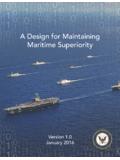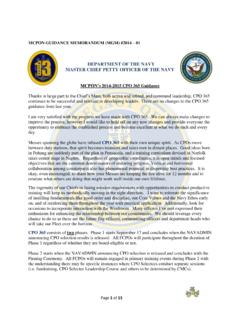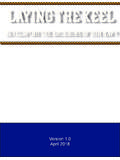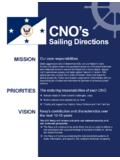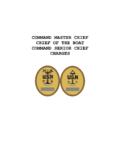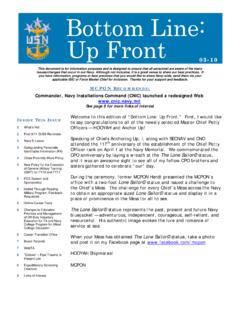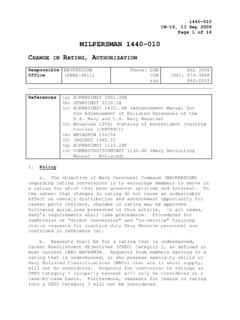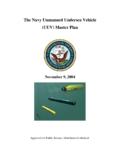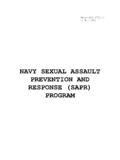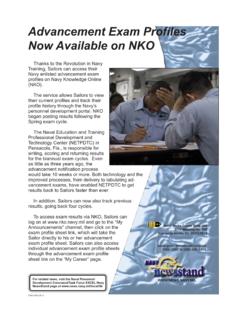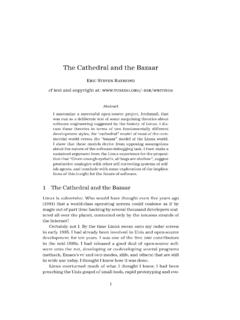Transcription of Growing to Win: Sailor 2025 Navy’s Strategy for …
1 1 Growing to Win: Sailor 2025 Navy s Strategy for People in our Future Fleet By Vice Adm. Robert Burke, Chief of Naval Personnel Just over two years ago we launched Sailor 2025 an evolving program of over 45 initiatives. It was about a long-overdue overhaul to the way we think about and execute career management everything from promotion and advancement, evaluations and fitreps, selection boards, educational and other professional development opportunities, and even detailing. We also knew we had to be smarter about training our increasingly technical force there were better ways to get the practical knowledge into our Sailors hands we could do it faster and in a way that sticks.
2 Finally, we knew we had to retool our system to be more like the business world we had to treat our Sailors like adults, be transparent, give them realistic choices, and even put some market forces to work. We then initiated a top-to-bottom transformation of the Navy s manpower and personnel enterprise to enable these programs and bring our Sailors the customer service they deserve and expect. Many of the programs are delivering. Many more are about to be released. When I talk about the specifics we re planning, Sailors are excited about the potential of these ideas. They jump in with ideas, and send more into our idea hotline some of our best programs came from Fleet Sailors.
3 They ve gotten a little taste of things to come with popular Sailor 2025 programs like the Meritorious Advancement Program (MAP), and know we mean business. But some Sailors are still just a bit skeptical that we may not really deliver on these promises. Well, we re very proud and especially excited that after the last two years of what was essentially foundational work, the Navy s personnel system will be the among the first in DoD to go into the commercial cloud. The latter half of 2018 will see the start of the roll-out of our personal mobile device accessible personnel services. By the end of 2019, Sailors will do most of their personnel business via smartphone ashore or desktop apps afloat.
4 By 2023, they will have forgotten about today s personnel system and many of its frequent frustrations. To let our Navy Team know what is happening, we have been talking about these innovations in NAVADMINs, articles, podcasts, videos and My Navy Portal postings. To cast the net even more widely, we are writing in PROCEEDINGs and using YouTube and other venues to let you know how you can continue to provide input to these Sailor -driven initiatives. I ask that you take this message to your shipmates be part of the solution, send your ideas directly to us, join one of the many Fleet working groups tackling various issues, or if you are interested, come do a shore assignment working in the personnel business it is a truly dynamic time for us.
5 We need your involvement and your ideas. Our systems were built before most of our Sailors were born and operate on system hardware with software programs and patches that date back to the 1960s. Navy personnel s organization, processes and infrastructure are complex, outdated, and inefficient. These factors 2 present challenges to sustain the enterprise in the future. The personnel system has not fundamentally transformed since the draft went away, and today s industrial age assembly line model is simply unsustainable. Your smartphone has more computing power, better software and update processes, and is more user friendly than ANY of our Navy s personnel IT systems.
6 Hands-down. Our detailers, community managers, and personnel who you interact with on a daily basis for personnel action work long hours and travel many miles to mitigate the significant personnel system deficiencies and bring you the best we can deliver. But, in spite of their herculean efforts and being THE BEST we can assign, we know we have to do better! That means a complete redesign of our entire lifecycle of industrial age processes. We need to change the way we do business in the personnel world and shift the focus from the business end to the customer, our Sailors. From a warfighting standpoint, the change is equally imperative while we re in a good position today with respect to recruiting, retention and manning, we are at a strategic cross-road we need to think about how we will conduct business for the Sailors of the future what skill sets will they need?
7 Will we be able to rapidly produce them in the required numbers? Will it be good enough to augment traditional forces for certain missions or periods of time? Our transformation efforts will streamline our processes and business models, making us more agile and responsive, and bringing you, our Sailors, some long overdue customer service. We re properly shifting the focus to career readiness not just for you, but personal readiness for your family as well. Focusing on our Sailors and their families to better meet their needs as their career progresses only makes sense it is the right thing to do for those who routinely go into harm s way.
8 So, we are aggressively transforming how we recruit, how we advertise jobs and assign our personnel, and how we train. While the last few years have been largely spent on foundational work, 2018 will see the beginning of new and exciting customer service models coming on line for our Sailors. We re doing this with Sailor 2025. Sailor 2025 When we started it in 2015, we used the term Sailor 2025 to challenge ourselves to think about what Sailors ten years in the future would expect and need, and to deliver those cutting-edge systems and policies now. Sailor 2025 is about empowering Commanding Officers and Sailors, updating policies, procedures, and operating systems, and providing the right training at the right time in the right way to ensure Sailors are ready for the Fleet.
9 We are providing choices, flexibility and transparency to our Sailors, and increasing the sustainability of our personnel system by enabling longer careers. Sailor 2025 is also about improving the FIT of our Sailors with the jobs we need them to do by offering them more choices and providing relevant and timely training. This innovation is built on a framework of three pillars: a modern personnel system, a career learning continuum that we call Ready, Relevant Learning, and 3 career readiness for the long-haul, a pillar that recognizes the importance of leader development, personal readiness, family readiness and life-work balance.
10 Personnel System Modernization (PSM) Our personnel system modernization initiatives are aimed at providing better tools to Sailors and leadership to empower Commanding Officers and give Sailors more choices and ownership over their careers. We are modernizing our personnel policies to increase flexibility and transparency, while allowing more capacity for the Navy to adapt to economic changes and corresponding effects on the recruiting market and retention. These programs are being rapidly spiraled out as fast as we can deliver them, and modified as we learn this is not Washington, business as usual. Many of these ideas originated in Fleet All-Hands calls.
